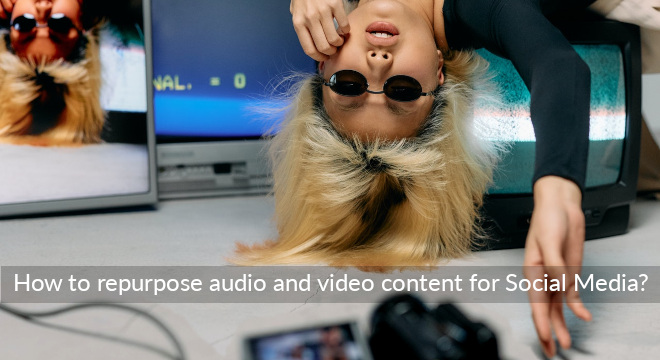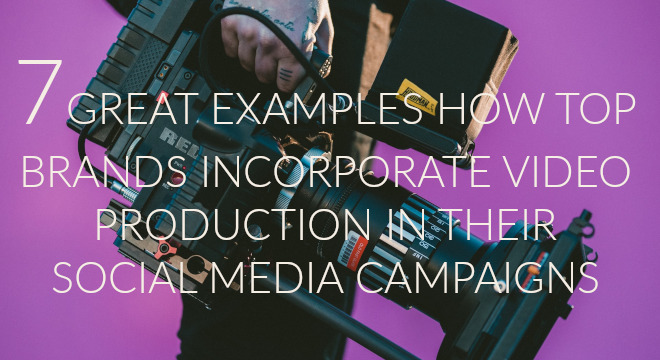
But what if you didn’t need fresh ideas? What if instead – by mixing up your marketing tactics with repurposing audio/video from existing sources- you can save time and also get more people to pay attention to your brand.
That’s the idea behind “repurposing” content. The act of turning old content into new stories is helping many brands reach audiences in new and engaging ways with their existing assets.
What it Means to Repurpose Audio and Video Content?
Repurposing content is the act of taking existing content and reformatting it to be used in a different way than its original purpose or for serving information to another target audience. It’s also known as “content recycling,” and the practice of revising all content elements to expand its outreach while ensuring the best experience for your audience.
Reusing old material instead of starting from scratch saves time and gets better results faster. Plus, each repurposed piece requires less effort than creating a whole new post or episode, so schedules can remain robust without growing too fast.
Why You Should Repurpose Audio and Video Content?
As with most marketing ventures, the more outlets you can provide for your message to reach its audience, the higher the chance of people seeing it. Video and audio content may be some of the most engaging media out there, but not everyone has time to watch or listen to an entire presentation or podcast episode.
Instead, you could shorten it to a Facebook post, a small Twitter video or audio clip, a Pinterest infographic, a Reddit infographic with images and links, or a Tumblr image with caption and explanatory text. The practice of shortening long-form audio or video content is incredibly successful for reaching younger audiences who may not have the time to dedicate to longer works.
To help repurpose your content for these types of outlets and others – like LinkedIn, if you’re trying to reach business professionals, you can use free online tools that allow you to quickly turn your audio or video into an image file to share on social media.
Repurposing this way also allows marketers more creative freedom with their messages since they aren’t obligated by the length of the original piece’s run time.
Let’s look at the various benefits of revised content. It will help freshen up your marketing leads:
- It’s cost effective; repurposed audio & video content can help marketers save time and money on creating multiple pieces of high-quality content instead of having to create it from scratch each time.
- Tapping into existing content not only saves you money but also drives traffic back to the original source which is great for SEO purposes.
- Creates value in older pieces by giving them fresh relevance and forcing consideration of their potential for contemporary business objectives. It also helps quickly adapt your content to changing conditions without having to re-do everything.
- Helps summarise all meaningful critical points into an infographic or social media post can help your audience get product insight in one go.
- Let’s suppose; few experts spoke about their experiences, tips, and tricks to come out of the situation. We can reuse these experiences to create content that truly speaks about genuine problems and proper solutions. It will help your audience and have higher chances to rank at the top of Google’s search engine for being relevant and relatable.
- Routinely repurposing your audio and video content can help you build a library of content that will be there for you as a “go-to” resource, as well as to meet daily or weekly deadlines.
How to Repurpose Old Audiovisual Content for Social media?
Audiovisual content is more challenging to repurpose than articles, but it is doable. The first thing you want to do is record some new video or voiceover for the old content. If you professionally shot your video, then you probably have something usable for YouTube. Audiences are still watching videos of all kinds on YouTube, so start there with your audiovisual content.
You could also take a slide show and record a voiceover. That would only be beneficial if you recorded it yourself or had access to the original recording. You can repurpose slideshows, but always consider quality before doing so.
Another way to repurpose audiovisual content for social media is by taking screen captures of slides or screenshots from your video and post those to Facebook or other sites. It works best for videos related to an event where you could take screenshots and a relevant quote throughout the presentation.
People love quotes, and they often share the image itself if there’s no link to click. Several programs available today make creating these types of images almost effortless, so you take something that might not be perfect and make it shareable.
[See related post: Five Benefits Of YouTube Marketing That Will Change Your Channel’s Perspective]
Examples of How Other People Have Successfully Reused Their Own Content
Buffer’s “No New Content” challenge back in 2015 is an excellent example of reusing content for social media. Buffer took the leap as a real-time content app and “stopped creating new content for social media.” They instead opted to make minor tweaks or updates to existing items that they had already posted to Facebook, Twitter, LinkedIn, etc.
While it was a concise challenge (it lasted only one month), it helped them create a system that allowed them to reuse much of their existing content with minimal extra effort.
Moz started Whiteboard Fridays videos to enhance engagement and later used the video content for the blog and social media posts.
SlideShare was able to get 200,000 views by tweaking its content with some new aspects.
Tips For Creating a Good Social Media Campaign Around Your Newly Repurposed Material
Sometimes, instead of creating new content, repurposed audio and video content can engage, convert and sell better. To get the most out of your repurposed content, it’s important to follow some best practices. Below are a few helpful tips:
Format – Give some consideration to how you’ll be posting your repurposed content too.
Are you going to upload the audio/video to your social media post? Or are you going to create a new story to share? You can also use your YouTube channel as it is a great place to gain visibility with your viewers because many people check out a company’s YouTube account after viewing a video on their website.
To start getting more views, likes, and subscribers from your videos, follow these two simple steps:
- Keep each video between two and five minutes in length. People view business videos on their mobile devices, so keeping each video short and to the point is essential.
- Include subtitles. You can use automatic subtitles generator like SubtitleBee that offers 100+ languages for subtitles and translations. It will help you overcome language barriers on YouTube and engage with larger audiences. Include English subtitles if your primary audience speaks English and subtitles in languages that other sizeable groups speak such as French, Spanish or Portuguese, etc.
Convert Videos into Podcasts
A podcast is a different way to show your expertise and dedication to your niche by telling authentic stories and real-time experiences. Your passion and speaking prowess give an authoritative tone to something that cannot be written or express in words.
You can also reuse podcasts audio and videos for your YouTube channel, short clips could be used in blogs and at social media handles.
Transcribe Videos for Blogs
Transcribing videos for the blog is an effective way to increase SEO, context, linkable content and share-ability. Using an outside service or online tools to transcribe your video into text can make this whole process more efficient.
Technology has moved up to the next advanced level and brought us AI-power-based tools with automation abilities to transcribe audio files into text with 99% accuracy. There will be a 1% chance of error based on the sound quality of the video. Besides the high-quality transcribing services, these tools can add exclusive subtitles and captions to your videos to increase the accessibility of your videos. Remember, the more accessible your content is, the more search optimisation level it will get.
Turn Internal Data into Case Studies
If your content has the credibility of offering solutions to real-time problems, you can turn it into a case study to show your readership some real-time insights. Repurposing audio and video content into case studies can give a unique and personalised edge to your business marketing strategy.
Collect Data for an E-Book
Ebooks boost the credibility of your business and help marketers to balance out the drips and plateaus in traffic and metrics. Publishing an ebook on in-depth insights that help your readership resolve their problems is a plus. Repurpose audio and video content to reinforce meaningful information into e-books.
Use Content for Social Media and Product Pages
Have you ever used some stunning testimonials to beef up your product as your social media strategy? Testimonials don’t only help gain the audience’s trust but also improve customer relationships. Showcasing testimonials and reviews sends out the message of your customers’ voice is being heard and it matters. Repurpose audio and video content to build a smart social media strategy.
Closing Thoughts
Repurposing content is an excellent way to get more mileage out of the blog posts, articles and audio/video pieces that you already have. Start repurposing today so that next time you do need to produce some original content, you don’t have to start from scratch.
[Recommended reading: 7 Great Examples How Top Brands Incorporate Video Production In Their Social Media Marketing Campaigns]
I’m a product marketer with a special interest in accessibility. I love everything about this industry, from the empathy that drives my work to the technology and design solutions it creates. I have an insatiable curiosity for how people use products and what they need to achieve their goals. I care deeply about creating inclusive experiences for all people—those who are disabled or disadvantaged as well as those who are neuro typical. The way we think of disability is changing, so I’m excited to lead the charge on making sure our products support individuals across the spectrum of ability and experience.


